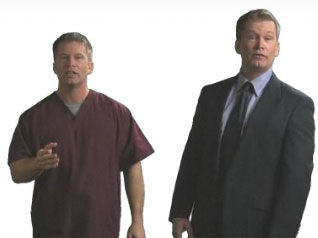 Technology has made it possible to place a website video spokesperson on your website. When done correctly, your virtual spokesperson can serve as a tour guide and sales agent. When done incorrectly, your Web video spokesperson can drive visitors away. Avoid these common mistakes and enhance the user experience.
Technology has made it possible to place a website video spokesperson on your website. When done correctly, your virtual spokesperson can serve as a tour guide and sales agent. When done incorrectly, your Web video spokesperson can drive visitors away. Avoid these common mistakes and enhance the user experience.
- Avoid allowing the website video spokesperson to speak before being clicked. It’s fine for your virtual spokesperson to walk onto the screen and wait, but the Web video spokesperson should never begin speaking until the user clicks.
- Avoid low quality video. Your website video spokesperson should appear in full HD video. Today’s users are accessing websites on screens of all sizes ranging from tiny cell phone screens to massive flat screen TVs.
- Avoid lengthy speeches. As with most online videos, your virtual spokesperson should respect your viewers’ time. Few Web visitors have the time, attention span, or desire to watch a lengthy video and many will resent been forced to listen to a long pitch.
- Avoid having the video spokesperson read the website text. This can turn off site visitors, possibly even insult their intelligence. Allow your virtual spokesperson to contribute to the conversation, when clicked, not rehash what already appears on the page.
- Avoid repeating the same video multiple times. Each Web page featuring your virtual spokesperson should have its own unique script tailored to the page’s content and desired call to action. Having the Web video spokesperson repeat the same information is redundant, boring, and annoying. Just as a real estate agent would point out the benefits of the family room while showing clients the family room and the merits of the master bathroom when showing the master bathroom, the same is true of the website video spokesperson. The script should be relevant to the page.
- Avoid generic scripts. Your company is unique so make sure that your virtual spokesperson accurately reflects that. While a generic “welcome to our site” might have longevity on its side, it doesn’t communicate what’s unique about your product, service, or brand.
- Avoid branded video players. Some entry-level Web video spokesperson service providers place their logos and links inside the video player as a means of keeping costs low. However, this is distracting and takes away from your core message.
- Avoid borders. Today’s video technology allows for borderless video overlays. Your website video spokesperson can literally walk across the screen.
- Avoid pushing and pull your visitors in. A virtual spokesperson can be used in many ways. You may be tempted to use your Web video spokesperson as a broadcaster who pushes a message to viewers. Put away the bullhorn and put your website video spokesperson to good use as a warm, inviting host. Write the script with user benefits in mind and create engaging copy. Use a soft sales approach and allow your virtual spokesperson to gently guide viewers to a compelling, relevant call to action.
- Avoid choosing the wrong Web video spokesperson for your site. The website video spokesperson will become the face of your company, so choose wisely. Make sure to select a virtual spokesperson that reflects your company’s values and resonates with your customers.
Clearly, you have a lot of considerations when opting for a Web video spokesperson. Though it may seem like a lot to remember, it all comes down to this: attracting and guiding visitors. Avoid anything that could drive visitors away and embrace techniques that can draw them in. If you can accomplish these two key points with your virtual spokesperson, your campaign is sure to be a success.
What website video spokesperson techniques annoy you? Which ones work well? Share your thoughts in the comments section below:













